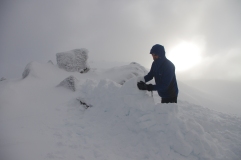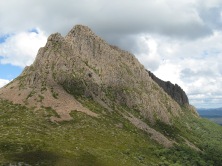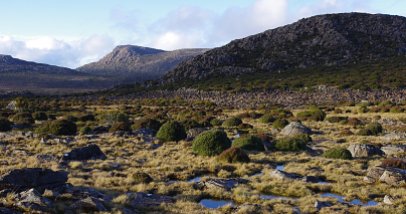Over the past couple of years, I have been talking with various land managers and career and volunteer firefighters about whether Victoria should establish a remote area firefighting capacity of volunteer fire fighters.
NSW, the ACT and Tasmania all have volunteer forces, who support career firefighters, adding considerable capacity to firefighting efforts in remote country like national parks. The Rural Fire Service (RFS) in NSW has Remote Area Fire Teams, with around 500 active volunteer firefighters.
It is clear climate change will make fire seasons more intense and will also lead to an increase in ‘dry lightning’ strikes, which will increase the number of wildfires. The value of the NSW model is shown by the effectiveness of their teams in stopping small fires becoming blazes: for instance, in the 2018/19 fire season the Rapid Aerial Response Teams responded to 77 incidents, and were able to keep 90 percent of the fires they attended contained to less than 10 hectares in size.
I think we should create a similar group in Victoria.
Large ‘campaign’ fires stretch our existing capacity
On New Year’s Eve, December 31, 2019, a front brought a smattering of rain across the Victorian mountains, barely enough to damp down the dust. But the associated lightning storm started dozens of new fires in a long belt from Mt Buller to the NSW border.
Forest Fire Management Victoria (FFMV) crews swung into action and many of these were quickly put out. Aerial bombing dealt with others. But there were simply too many, and some grew into massive blazes, including the fires that went on to devastate the forests and landscapes of East Gippsland in coming weeks.
This raises the question: Do we need a new remote area volunteer firefighting force in Victoria who could help suppress lightning strike fires before they take off?
The situation at present
 Forest Fire Management Victoria crews are made up of firefighters from the Department of Environment, Land, Water and Planning (DELWP), Parks Victoria, VicForests and Melbourne Water. It’s mission is to ‘reduce the risk and impact of bushfires on Victoria’s parks, forests and other public land’. FFMV crews also support the CFA to fight fires on private land. FFMV has a permanent workforce of career firefighters and also employs seasonal firefighters over the fire season, generally from November/December until the end of March.
Forest Fire Management Victoria crews are made up of firefighters from the Department of Environment, Land, Water and Planning (DELWP), Parks Victoria, VicForests and Melbourne Water. It’s mission is to ‘reduce the risk and impact of bushfires on Victoria’s parks, forests and other public land’. FFMV crews also support the CFA to fight fires on private land. FFMV has a permanent workforce of career firefighters and also employs seasonal firefighters over the fire season, generally from November/December until the end of March.
About a third of Victoria is public land. Much of it is remote, mountainous and inaccessible, and fires in these areas are usually caused by lightning which, if not rapidly suppressed, can grow in size quickly. Apart from sending FFMV crews in by truck, specialist remote area firefighters may be dropped in by helicopter. DELWP currently has four seven-person rappel crews employed during the fire season which are based at Heyfield in Gippsland and Ovens in north east Victoria. It has access to a range of air support, including Large Air Tankers (LATs) and Very Large Air Tankers (VLATs), and helicopters that are able to drop water and/or fire retardants onto forested areas. It adds at least 600 additional fighters every summer to its permanent force. In the 2019/20 fire season, this year FFMV crews suppressed 89% of all new ignitions with aggressive ‘first attack’ techniques.
Despite these resources, many of these small lightning triggered fires grew in size and subsequently devastated large areas of the mountains and foothills. Partly this was influenced by the conditions. For instance, on January 4, as another front came through, wind conditions were so extreme that all FFMV crews had to be pulled out of forested areas because of the danger of falling trees. With large fires along the eastern NSW and elsewhere, there were also limitations on the availability of aerial bombing capacity.
 It is clear climate change will make fire seasons more intense and will also lead to an increase in dangerous firestorms that were once considered rare: pyrocumulonimbus (pyroCB), often referred to as firestorms, which can create their own weather and start fires by generating lightning. Fire seasons will start earlier and last longer. Fire seasons across Australia and in the northern hemisphere used to be separated by months – allowing exchange of vital equipment such as aerial water bombers and firefighters. The increasing overlap of fire seasons between states and territories and with the USA and Canada will limit our ability to help each other during major emergencies. The window to carry out fuel reduction burning will get narrower. The ecological impacts on foothill and mountain forests will continue to grow, as will the economic impacts on mountain and valley communities.
It is clear climate change will make fire seasons more intense and will also lead to an increase in dangerous firestorms that were once considered rare: pyrocumulonimbus (pyroCB), often referred to as firestorms, which can create their own weather and start fires by generating lightning. Fire seasons will start earlier and last longer. Fire seasons across Australia and in the northern hemisphere used to be separated by months – allowing exchange of vital equipment such as aerial water bombers and firefighters. The increasing overlap of fire seasons between states and territories and with the USA and Canada will limit our ability to help each other during major emergencies. The window to carry out fuel reduction burning will get narrower. The ecological impacts on foothill and mountain forests will continue to grow, as will the economic impacts on mountain and valley communities.
We need extra firefighting capacity to protect the mountains
It is clear we will need more capacity to fight fires in the mountains. There are four obvious options:
- Continue to invest in air support to fight fires in remote areas, with continued resource sharing between the states and overseas jurisdictions, to access additional planes and helicopters when needed. Victoria has done a good job in this regard, with a large fleet available over summer. The federal government, however, continues to resist the call to establish a publicly owned air fleet of large aircraft.
- Continue to increase the number of paid seasonal firefighters, including additional allocation of funds and training to expand the number of remote area firefighters. In a good move, the Victorian government has done this, and added extra FFMV firefighters to existing crews.
- The federal government should establish a national remote area firefighting force which can be deployed as needed across Tasmania and mainland states when World Heritage and National Parks are at risk. This was recommended by a Senate inquiry after the devastating fires in Tasmania of 2016.
 We need to do all of these things, and more. But given the scale of fires across the state and around Australia, it is clear that, even with additional resourcing as outlined above, there will be ever more demands on fire fighting capacity in coming years. As happened during the 2019/20 summer, with fires along the east coast and in South Australia at the same time, it became harder to share fire crews between states and territories. With longer fire seasons around the world, it will also place stress on traditional allies like the USA and Canada, who send firefighters to help us during their off season. And the volunteer services, like Victoria’s CFA and the RFS from NSW, will struggle to sustain the numbers required to send Strike Teams interstate and to large fires when they are busy at home fighting bushfires. This means that incident managers must sometimes priortise protection of human assets over protection of natural systems where resources are limited.
We need to do all of these things, and more. But given the scale of fires across the state and around Australia, it is clear that, even with additional resourcing as outlined above, there will be ever more demands on fire fighting capacity in coming years. As happened during the 2019/20 summer, with fires along the east coast and in South Australia at the same time, it became harder to share fire crews between states and territories. With longer fire seasons around the world, it will also place stress on traditional allies like the USA and Canada, who send firefighters to help us during their off season. And the volunteer services, like Victoria’s CFA and the RFS from NSW, will struggle to sustain the numbers required to send Strike Teams interstate and to large fires when they are busy at home fighting bushfires. This means that incident managers must sometimes priortise protection of human assets over protection of natural systems where resources are limited.
A fourth option to consider is to develop a new volunteer firefighting force specifically tasked with adding capacity to state government firefighting agencies when fires threaten national parks, wilderness and World Heritage Areas.
Dry lightning storms will become ever more common under climate change scenarios. This is already the case in western Tasmania. More lightning means more fires in remote areas. In addition, and as noted above, increased incidence of pyrocumulonimbus plume clouds during bushfires can generate dry lightning which can trigger fires.
The summer of 2019/20 made it clear that there wasn’t enough capacity to attack all fires after major lightning strike events.
While FFMV crews did an incredible job (as did the air support who extinguished many fires after the December 31st lightning storm), there were simply too many to contain with the resources available. If there had been additional remote area teams able to hike into fire ignition points, we may have stopped some of the fires that subsequently turned into major blazes. One example is the Tabletop fire near Mt Hotham that joined fires in the Upper Victoria River, then others, eventually burnt more than 44,000 ha, and almost destroyed the township of Dinner Plain. If a small crew had been available to hike in and put the fire out on January 1 or 2, we may have avoided the significant costs of having to fight this enormous fire (eg, a CFA strike team to defend Dinner Plain and Mt Hotham village and houses in the Cobungra area, and the air support that was allocated to stopping the fire, etc).
The NSW Rural Fire Service (RFS) has Remote Area Fire Teams (RAFT) that are composed of volunteer firefighters and could act as a template for a Victorian team. They help compliment the work done by NSW National Parks and Wildlife Service (NPWS) remote area crews. Many are members of local RFS brigades and turn out to ‘regular’ fires with their brigade but may also be called up for remote area firefighting.
 There are also Rapid Aerial Response Teams (RART), which is a program within the RFS where specially trained firefighting teams (trained RAFT Firefighters) are ‘placed on standby at appropriate times and in appropriate places, transported by helicopter to the scene of an incident when needed and, if necessary, transferred to the ground by winching or similar insertion’ (source).
There are also Rapid Aerial Response Teams (RART), which is a program within the RFS where specially trained firefighting teams (trained RAFT Firefighters) are ‘placed on standby at appropriate times and in appropriate places, transported by helicopter to the scene of an incident when needed and, if necessary, transferred to the ground by winching or similar insertion’ (source).
The RART programme was introduced within the NSW RFS in 2011 as a response from the Victorian Royal Commission findings into the 2009 fires. The idea is that when certain weather conditions are forecast a standby RAFT team and a winch capable medium helicopter are mobilised, ready to deploy, for a period of time to instantly respond upon a report of a new fire.
The NSW RFS has 27 RAFT Units across the state, with a total of about 500 personnel. The value of the NSW model is shown by the effectiveness of their teams in stopping fires becoming blazes.
And now Tasmania is establishing a similar program, and trained the first of 30 volunteer firefighters last year.
These volunteers were chosen from 190 applicants and will provide support for the 100 existing Tasmania Fire Service remote-trained career firefighters, and 80 from Parks and Wildlife, over summer. The large number of applications shows that such a program, if developed in Victoria would be likely to attract considerable interest.
A Victorian remote area force:
It could be a stand alone fire fighting force which is trained by the relevant government authority. For instance, in Victoria, they would be trained to the standard of the seasonal firefighters employed by FFMV. They may require additional medical and fitness tests, and additional training in ‘dry’ firefighting techniques, Helicopter Insertion Techniques (as per the RFS model), and the Operate in Remote Environments (ORE) training undertaken within the RFS (source, p 74). In NSW there is a specialised training capacity for RAFT and RART volunteers, run through Ops Support (previously called the Remote Area Firefighting and Specialised Operations, or RAFSO). A similar training capacity should be established in Victoria.
The RFS also has an Arduous Firefighter Program, which was introduced in 2016 as a stepping stone between normal ‘tanker based’ firefighters and RAFT firefighters. This was partly help train people to be ready for interstate and international deployments. An Arduous Firefighter in the NSW RFS has at least a couple of years’ firefighting experience. They may then decide to do ORE training to qualify as a RAFT volunteer.
- As a volunteer unit it would make sense for it to be hosted by the CFA
- It would make sense to do a small pilot effort in the first season, to review and scale up in the following year
- It would receive support from the state government (training, uniforms, meals when on deployment, equipment, and potentially vehicles, etc)
- They could be mobilised at the start of each fire season. Members who have the required qualifications and other state requirements (eg burn over drill and hazardous trees training) could nominate to be available for that season and then opt into possible strike team deployment on a weekly basis. These would be deployed via the state authority as volunteer strike teams are allocated at present, with priority given to deployment on remote area fires. Unlike a standard strike team deployment where members often leave from their home station in an appliance, volunteers may need to get themselves to a staging point near the fire, or the state government may organise transport from major cities or regional centres. Additionally, these firefighters could simply be regular members of their local CFA brigade, and nominate to join remote deployments when a call out is made. This could be easily managed at an operational level as brigades regularly nominate members to join Strike Teams during fire season
- The organisation would be administered and supported by staff seconded from Fire Rescue Victoria, as per the arrangement with the CFA
- Teams would be deployed from the staging point to the fire ground via vehicles or air travel operated by the relevant state agency (PV, DELWP, Melbourne Water). In NSW, RAFT teams are managed / deployed at the District level
- They would be specifically allocated where remote access is required on public lands – eg walk in firefighting, blackout and mopping up using dry firefighting techniques, etc. A key priority would be for them to be deployed to attack new fires triggered by lightning in mountainous and remote areas when air support is not available
- They may also be deployed alongside regular volunteer units who are allocated to campaign fires on public land
The Joint Operational Protocols for Remote Area Firefighting in NSW are available here.
The Operational Protocols for NSW RART which is used in NSW are available here and include details on how RART teams are dispatched and managed.
Developing a volunteer fire fighting force based in the CFA will require some changes in how Victoria manages fires. DELWP or FFMV automatically take control of fires on public land, whereas in NSW, the RFS is generally the lead combat agency for fires. Section 44 of the RFS Act gives the RFS Commissioner powers to take over the running of any fire and appoint an Incident Controller. So any agreement to establish a Victorian version of RAFT will require an agreement between DELWP/ FFMV and the CFA.
Creating opportunities for younger and urban based volunteer firefighters
We believe there is an additional benefit that would come with the establishment of a volunteer force which is focused on ‘campaign’ fires rather than being based in a local brigade. Many volunteer fire brigades in rural areas are aging. As fire seasons worsen and become longer, there will be greater pressure on these local brigades to help provide the ‘surge capacity’ needed to fight big campaign fires. While the peri-urban brigades do tend to provide much of the surge capacity at present, membership of these brigades is limited to people who live near a fire station.
A volunteer remote area firefighting force would, by its virtue of its activity – which will include remote area work requiring robust fitness – attract younger and potentially urban based members, which would create a pathway for many new people to sign up for volunteer fire fighting who do not live in the catchment of an existing brigade. This would, over time, provide substantial benefits to existing volunteer forces like the CFA, because it would increase its base of trained and active firefighters who can be available during the summer months.
Creating a volunteer firefighting role which is not linked to existing brigades would be most useful for attracting new urban members. It may be possible to create urban based brigades specifically for the volunteer remote area firefighters, and these could potentially be co-located in SES Units in suburban Melbourne, where there is room available.
Recruit training could be done as a block, potentially in a residential situation, and potentially timed during university holidays to make it more likely that urban based young people would be able to join.
How might it work?
- Potential fire fighters from urban areas join the CFA, and do their normal training, ideally in the mid year holidays (General Firefighter training, burn over drill and hazardous trees. Some additional ‘arduous’ fire fighter tests or training may be required).
- They join the new Remote areas Fire Fighting Team. They may also be able to join an urban brigade if there are sufficient numbers in specific areas.
- They would, at the start of a fire season, be asked to indicate their availability for that summer.
While there are serious budget constraints in Victoria, and the government has invested heavily in a range of fire fighting efforts, this proposal could provide a considerable boost to our state’s firefighting capacity at relatively low cost to the government.
























































September 9, 2022 at 3:01 pm
Hi Cam,
I just wrote a detailed reply but it gort obliterated by word press!
In a nutshell, your ideas are great because they follow the best scientific evidence we have.
But politics is important. Every year, those who oppose indiscrimate burn offs are wrongly blamed for disastrous fires.
Outreach and education about the science for those living in fire- prone areas are very important. Without strong local support, the programs could be shut down, whether or not they are successful in saving habitat, lives and property, due to misinformation and disinformation. I realise that you do this really well already!